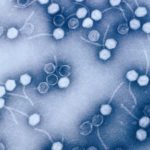Lien vers Pubmed [PMID] – 33483589
Lien DOI – 10410.1038/s42003-020-01623-8
Commun Biol 2021 Jan; 4(1): 104
Endogenous viruses form an important proportion of eukaryote genomes and a source of novel functions. How large DNA viruses integrated into a genome evolve when they confer a benefit to their host, however, remains unknown. Bracoviruses are essential for the parasitism success of parasitoid wasps, into whose genomes they integrated ~103 million years ago. Here we show, from the assembly of a parasitoid wasp genome at a chromosomal scale, that bracovirus genes colonized all ten chromosomes of Cotesia congregata. Most form clusters of genes involved in particle production or parasitism success. Genomic comparison with another wasp, Microplitis demolitor, revealed that these clusters were already established ~53 mya and thus belong to remarkably stable genomic structures, the architectures of which are evolutionary constrained. Transcriptomic analyses highlight temporal synchronization of viral gene expression without resulting in immune gene induction, suggesting that no conflicts remain between ancient symbiotic partners when benefits to them converge.




